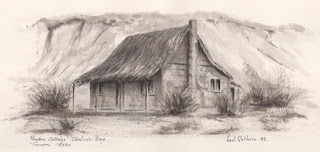Opawa famous for its hospitality
Opawa famous for its hospitality
 |
| Chamberlain School |
This settlement emerged out of the Opawa Sheep Station and at the time, Opawa was said to have been famous for its hospitality. John Rutherford, who owned the Station, was one of the most popular men in South Canterbury .
A flock of emus that John was breeding at that time became popular with the local youngsters. Of course, these kids did not only go to Opawa to see the emus, John had a large orchard consisting of plum, apple, peach and pear trees and made sure that all children never went home empty handed.
In 1902, Opawa Station, already depleted somewhat from its original size, was sold to the Government for forty-two thousand pounds. The hill country was divided into three grazing Runs varying in size from forty to four hundred hectares each.
The homestead block contained two hundred and fifty hectares and was retained by John Rutherford. It and the rest were contained in what became known as the Chamberlain Settlement Block.
The name Chamberlain originated in recognition of Sir Joseph Chamberlain, Chancellor of the Exchequer in the British parliament, who from what I can gather was a close friend of Richard Seddon, our own Prime Minister at the time.
Until his death, John Rutherford, as a self-appointed ‘laird’ of the district, took a keen interest in the people who had settled on the Chamberlain subdivision. Twenty-three settlers came into the district, most of whom brought with them a family, who in due course would need an education.
Each year John is said to have sponsored a picnic at his homestead for all the people in the settlement and generously gave a five-pound note to all those babies born during the year.
During 1904, a one-roomed school building was erected on Blainslie Road , near the centre of the Chamberlain Settlement and from those memories handed down over the years; I gleaned some of the school's histories.
Until 1908, teachers at the school boarded with parents of the district when a schoolhouse was erected, then during 1915, an additional classroom was added to the school.
Recollections were of windows so high, that the sun seldom touched the floor in the winter and of inkwells which were fitted into the long bench type desks and where students sat on long backless forms.
A water tank stood by the corner of the building on a wooden stand and a badly beaten old tin mug tied to the tank by a length of string was used to quench one’s thirst.
Most children walked to school, but for a year or so one family of five school-age children travelled to school in a dog cart, designed and built by their dad. Four families, Morrison’s, Stirling ’s, Willets, and Williams were all represented by the eleven first day pupils at Chamberlain in 1904.
By about 1915, there were between forty and fifty children attending class. However by 1938, due to a declining role, Chamberlain was forced into closing its doors for the final time and amalgamate with the Albury School


Comments
Post a Comment